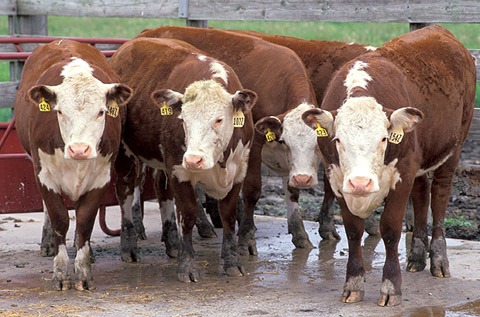
From /www.texascattleraisers.org Rancher’s Managment Guide:
Let buyers know what to expect from your calves by letting them know how you manage your cows.
By Kristen Odom
Having a management program in place is key for the calf crop going into a feedyard, but it is equally important to have an efficient management program for the cow herd and to let buyers know about it.
“First, it’s important to have a good, sound preventative program in the cow herd,” Dr. Ted McCollum, Texas AgriLife Extension beef cattle specialist, says. “That program needs to be driven by the (producers’) interaction with their veterinarian from their region.”
“A lot of the routine things that sound so simple really make an impact on the calf in the feedyard,” Dr. Steve Lewis, consulting feedyard veterinarian, says.
There are diseases and viruses for which the vaccination of the cow can establish some early immunity in the calf. This helps the calves to establish a lifelong immunity that may reduce problems once they leave the ranch, McCollum explains.
From the time the calf is in the uterus and later, a good vaccination program for the cow supports the calf’s likelihood of developing a better immune system and remaining a healthy calf later in life. McCollum says the development of the maternal antibodies that are passed to the calf in colostrum early in life can help them later in life.
“We need to do everything we can do to develop that immune system, make the calf healthier and make them more prepared to face some of the stressors as they are weaned and they transition up into the next level in the beef industry,” McCollum says. “Anything we can do to increase their ability to handle those stressors is going to improve the efficiency of that calf later.”
Better nutrition, better health
McCollum suggests that it’s good to have some idea of the mineral supplement programs used at the ranch. If cattle aren’t managed well nutritionally, it is probable that the health of the resulting calves may be compromised.
“We see nutritional management as really important, especially just the basic trace minerals and vitamins,” Lewis says. “That is going to help the ranch’s number of live calves born and live calves weaned.”
Lewis explains that if the calves have adequate nutrition coming into a feedyard, even if they have had no vaccine program, the calves will respond to a vaccine much better than a calf that has not been kept on an adequate nutritional program.
Protein is important, too. Even when trace minerals and vitamins have been provided but protein supplementation during drought has been neglected, calves can experience dramatic health effects in the feedyard. “The calves can’t respond to vaccinations if they don’t have the tools with which to respond,” Lewis says.
McCollum says any information that can be passed to the next segment of the beef production industry with the cattle is beneficial. “That gives the person who has purchased or will be managing the calves at the next level an idea of what they might be facing in terms of management difficulties or other things they may have to adjust their management around,” McCollum explains.
The basics help with efficiency
“The BVD-persistently infected (PI) calves are a tremendous economic loss. With BVD-PI calves, sometimes it is hard for ranchers to know exactly what is causing problems,” Lewis explains. Poor performance or calf losses might be blamed on a “dry year or the bulls weren’t any good or just other things to explain because BVD doesn’t send out a red flag,” he says.
Lewis says the cow-calf herd is the place where the greatest return on cost is acquired for BVD testing.
To increase efficiency in the cow herd, Lewis recommends establishing a vaccination program against IBR and BVD respiratory diseases, clostridial diseases such as blackleg and malignant edema, and for diseases that cause losses in live calves born such as lepto, vibrio, and trichomoniasis. Calves should be vaccinated for IBR, BVD, and Pasteurella respiratory diseases in addition to the clostridial diseases.
“Find a time when you can evaluate the animal by body frame condition, calf performance, her reproductive history and her age and do some culling at that time,” Lewis advises. “Once you have done that, you want to set up a system for biosecurity. You don’t want to ruin what you have already invested in,” Lewis says.
Any animals purchased and brought into the herd need to be checked for brucellosis, tuberculosis and BVD-PI, and to be quarantined for the appropriate amount of time recommended by your veterinarian. Replacement heifers should be vaccinated with modified live IBR and BVD vaccines before entering the cow herd.
“Creating the best program in the cow allows us to produce the best program in the calf,” Lewis says.
